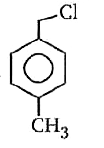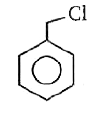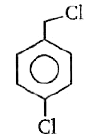Which one is the most reactive towards SN1 reaction ?
Ph−CH2−Br
Ph−CH∣Ph−Br
Ph−CH∣CH3−Br
Ph−CH∣C∣Ph−Br
The correct Answer is:4
To determine which compound is the most reactive towards an SN1 reaction, we need to analyze the stability of the carbocations formed during the reaction. The stability of carbocations is crucial because the SN1 mechanism involves the formation of a carbocation intermediate.
1. Understand the SN1 Mechanism:
- The SN1 reaction is a two-step process. The first step involves the formation of a carbocation, and the second step involves the nucleophile attacking the carbocation.
- The stability of the carbocation formed is the key factor in determining the reactivity of the compound towards the SN1 reaction.
2. Identify Carbocation Types:
- Carbocations can be classified as primary, secondary, or tertiary based on the number of alkyl groups attached to the positively charged carbon:
- Primary Carbocation: One alkyl group attached (least stable).
- Secondary Carbocation: Two alkyl groups attached (more stable than primary).
- Tertiary Carbocation: Three alkyl groups attached (most stable).
3. Analyze the Given Compounds:
- Convert each compound into its corresponding carbocation:
- If a compound forms a primary carbocation, it will be the least reactive.
- If it forms a secondary carbocation, it will be more reactive than primary but less than tertiary.
- If it forms a tertiary carbocation, it will be the most reactive.
4. Determine the Most Reactive Compound:
- After analyzing the compounds, identify which one forms a tertiary carbocation.
- The compound that leads to the formation of a tertiary carbocation will be the most reactive towards the SN1 reaction.
5. Conclusion:
- The fourth compound, which forms a tertiary carbocation, is the most reactive towards the SN1 reaction due to the stability of the tertiary carbocation.
Final Answer:
The fourth compound is the most reactive towards the SN1 reaction.
- The SN1 reaction is a two-step process. The first step involves the formation of a carbocation, and the second step involves the nucleophile attacking the carbocation.
- The stability of the carbocation formed is the key factor in determining the reactivity of the compound towards the SN1 reaction.
- Carbocations can be classified as primary, secondary, or tertiary based on the number of alkyl groups attached to the positively charged carbon:
- Primary Carbocation: One alkyl group attached (least stable).
- Secondary Carbocation: Two alkyl groups attached (more stable than primary).
- Tertiary Carbocation: Three alkyl groups attached (most stable).
- Convert each compound into its corresponding carbocation:
- If a compound forms a primary carbocation, it will be the least reactive.
- If it forms a secondary carbocation, it will be more reactive than primary but less than tertiary.
- If it forms a tertiary carbocation, it will be the most reactive.
- After analyzing the compounds, identify which one forms a tertiary carbocation.
- The compound that leads to the formation of a tertiary carbocation will be the most reactive towards the SN1 reaction.
- The fourth compound, which forms a tertiary carbocation, is the most reactive towards the SN1 reaction due to the stability of the tertiary carbocation.
The fourth compound is the most reactive towards the SN1 reaction.
Topper's Solved these Questions
- HALOALKANES AND HALOARENES BOOK - AAKASH INSTITUTE ENGLISHCHAPTER - HALOALKANES AND HALOARENES EXERCISE - Assignment (Section - B ) ( Objective Type Question(One option is correct ))
36 Videos
- HALOALKANES AND HALOARENES BOOK - AAKASH INSTITUTE ENGLISHCHAPTER - HALOALKANES AND HALOARENES EXERCISE - Assignment (Section - C ) ( Objective Type Question(More than one options are correct ))
17 Videos
- HALOALKANES AND HALOARENES BOOK - AAKASH INSTITUTE ENGLISHCHAPTER - HALOALKANES AND HALOARENES EXERCISE - Illustration
6 Videos
- GENERAL PRINCIPLES AND PROCESSES OF ISOLATION OF ELEMENTSBOOK - AAKASH INSTITUTE ENGLISHCHAPTER - GENERAL PRINCIPLES AND PROCESSES OF ISOLATION OF ELEMENTSEXERCISE - Try Yourself
33 Videos
- HYDROCARBONSBOOK - AAKASH INSTITUTE ENGLISHCHAPTER - HYDROCARBONSEXERCISE - Assignment(Section - C) (Previous Years Questions)
60 Videos
Similar Questions
Knowledge Check
Which of the following is most reactive towardSN2 reaction ?
A B
B C
C D
D
Which of the following is most reactive towardSN2 reaction ?
ACH2=CH−CH2−ClBPh−CH2−ClC DPh−C∣∣O−CH2−Cl
DPh−C∣∣O−CH2−Cl
Which one is most reactive towards AgNO3
View SolutionThe most reactive towards SN1 is:
View SolutionMost reactive halide towards SN1 reactions is
View SolutionWrite the structure of an isomer of compound C4H9Br which is most reactive towards SN1 reaction.
View SolutionThe following compounds are given to you
2-Bromopentane,2-Bromo-2-methylbutane,1-Bromopentane
(a) Write the compound which is most reactive towards SN2 reaction.
(b) Write the compound which is optically active.
(c). Write the compound which is most reactive towards β-elimination reaction.
View SolutionWhich of these shows highest reactivity towards SN2 reaction?
View Solution
